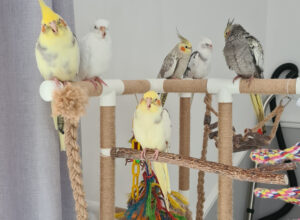Training Cockatiels: Basic Commands
Key Takeaways
- Starting Training: Begin with trust-building exercises to create a strong foundation for training.
- Commands: Learn to teach your cockatiel simple commands such as “step up”, “come”, and “stay”.
- Positive Reinforcement: Use treats and praise to reward your bird for following commands.
- Consistency Is Key: Regular, short training sessions help reinforce learning.
- Patience Pays Off: Training takes time, but with patience, your cockatiel will learn the commands.
Introduction
Training a cockatiel can be both a rewarding and challenging experience. I’ve learned that patience (lots of patience!), consistency, and understanding are essential in teaching these intelligent birds basic commands.
Starting Your Training Journey
Training a cockatiel begins with establishing trust. This foundational step is crucial as it sets the stage for all future interactions. Here are practical steps to start training your cockatiel:
- Spend Time Together: Dedicate time each day to be near your cockatiel’s cage, talking softly and offering treats from your hand.
- Respect Their Space: Initially, avoid making direct contact if your cockatiel seems scared or hesitant.
- Introduce Your Hand: Gradually, introduce your hand into the cage with a treat, allowing your bird to come to you.
- First Command – “Step Up”: Once trust is established, use the command “step up” while gently pressing against their chest. Reward with treats and praise.
Remember, patience is vital. Trust-building can take from a few days to several weeks depending on the individual bird.
Basic Commands and Training Techniques
After establishing trust, you can begin teaching your cockatiel basic commands. Here are some to start with:
1. Step Up
This command helps with handling your bird.
- Technique: Gently press your finger against the lower chest.
- Reward: Treat and verbal praise when they step up.
2. Come
Teaching your bird to come when called enhances their safety.
- Technique: Extend your arm and call their name.
- Reward: Offer a favourite treat upon compliance.
3. Stay
This command teaches your bird to remain in place.
- Technique: Use a hand signal, such as an open palm, while saying “stay”.
- Reward: Gradually increase the time before rewarding with a treat.
Basic Command Techniques
| Command | Technique | Reward |
|---|---|---|
| Step Up | Press finger against chest | Treat and praise |
| Come | Extend arm, call name | Favourite treat |
| Stay | Hand signal (open palm) and say “stay” | Treat after increasing time |
Positive Reinforcement: Always use positive reinforcement such as treats or verbal praise to reward your cockatiel for following a command. Avoid negative reinforcement or punishment as it can lead to fear and mistrust.
Advanced Tips and Troubleshooting
Consistency and Routine
Consistent, daily training sessions of 5-10 minutes are more effective than longer, less frequent sessions. Birds thrive on routine and predictability.
Patience and Expectations
Be patient and manage your expectations. Progress may be slow, but each small step is a victory.
Dealing with Setbacks
If your cockatiel seems to forget a command or becomes less responsive, take a step back and reinforce previous steps. They may need a reminder or additional practice.
Beyond Basics: Enrichment and Care
Training extends beyond commands. Providing a stimulating environment is key for your cockatiel’s mental and physical well-being. Explore these areas for comprehensive care:
- Essential Cockatiel Care
- Setting Up Cockatiel Cage
- Cockatiel Feeding Basics
- Understanding Cockatiel Behaviour
- Daily Cockatiel Care
- Cockatiel Exercise and Play
Conclusion
Training your cockatiel requires time, patience, and understanding. Establishing trust is the first step, followed by teaching basic commands using positive reinforcement. Remember, training is not just about commands; it’s about building a relationship with your bird. With the right approach and techniques, training your cockatiel can be a rewarding experience that strengthens your bond and enhances their well-being.

